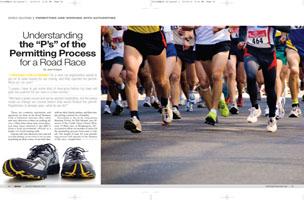
“I applied for a permit for a race my organization wants to put on to raise money for our charity, and they rejected the permit. What do I do now?”
“I guess I have to get some kind of insurance before my town will give me a permit for our race in a few months.”
“We have a great course and we’ve opened registration, but the police made us change our course before they would finalize the permit. Registration is already open, what do we do?”
 These are common statements and questions we hear at the Road Runners Club of America’s national office when new race directors contact us seeking advice. Often times these new event directors have been referred to the RRCA from a local government official or a leader of a local running club.
These are common statements and questions we hear at the Road Runners Club of America’s national office when new race directors contact us seeking advice. Often times these new event directors have been referred to the RRCA from a local government official or a leader of a local running club.
Anyone who has directed a race can tell you that putting on an event is not as easy as picking an ideal course, on an ideal date, with an ideal charity partner, and then simply getting a permit as a formality.
According to the book, Organizing Running Events, by Phil Stewart, race director of the Credit Union Cherry Blossom 10 Mile race in Washington, DC, you need to allow six months or more for the permitting process from start to finish. The length of time for your permitting process will depend on the distance of the race, complexities of the event, expected participant numbers for the race, and other factors that affect putting on a local road race.
For 28 years, Road Race Management, Inc. has hosted an annual race directors conference focused on sharing best practices in road race management. One of the general sessions at the 2011 Road Race Management Race Directors Conference was The Changing Local Political Landscape for Events led by William LaForge, JD.
LaForge is an attorney in private practice and the principal of LaForge Government Relations, a government relations and lobbying firm. For more than 30 years, LaForge has been involved with the public policy arena at local, state and federal levels. An avid runner and a triathlete, LaForge has completed 61 marathons, including 24 Boston Marathons, and he has logged more than 66,000 miles running.
At the Race Directors Conference, Laforge outlined the important “P’s” of the permitting process:
Planning Prevents Poor Performance in Permitting.
He underscored the importance of understanding the standards of review of a government board. In a nutshell, you need to know the permitting process in your community well in advance of planning your event and applying for a permit.
|
Photo courtesy of Jean Knaack |
LaForge also stressed the importance of understanding the “P’s” of working with your local government, which includes: process, people, priorities, and political environment.
Do your homework to know the process. Learn about the people involved in the process. Learn about local priorities for events including economic impact opportunities. Understand the political environment. Does your community have a physical activity plan that you can capitalize on to promote your event?
Next you will need to focus on dotting your “I’s” as you prepare your permit application:
Issues, Interest, Institutions, Information, and Influence
Issues – Learn about and understand what issues may come up during the permitting process. Perhaps your proposed date already coincides with another event on the calendar. Perhaps there is planned road construction on a preferred course route. Trying to forecast issues can help you plan for solutions throughout the process.
Interest – Why should the community have an interest in supporting your event? This is where you will want to spend some time and effort researching the potential economic impact of your race for the community. You can also include information about the race’s potential health impact benefits in support of national efforts to promote physical activity and healthy lifestyle choices. Working with your local chamber of commerce, convention and visitors bureau or sports commission can help you identify community interests and how to capitalize on the services of these groups to make your event a success.
|
Photo courtesy of Jean Knaack |
Institutions – Know what agencies and/or community groups will be involved in the permitting process. In some areas such as Washington, DC, event directors can work with several different law enforcement agencies including the U.S. Park Police, Capital Police, and D.C. Police, depending on the proposed route. Event directors will also work with multiple agencies within the D.C. government for sanitation, transit and more. Also know what community groups, businesses, faith-based organizations, and other groups will be impacted both positively and negatively by your event. According to Stewart in Organizing Road Events, “If your race is held on a Sunday and goes by any churches, you may have to make modifications to the start time of your event.”
Information – According to LaForge, “Information is like currency in the permitting process. The more you have, the better off you will be.” Use information to educate officials and advocate for the common benefit of your race. Provide facts, figures, and special interest stories. If your event is to raise money and awareness for charity, be sure to outline how the charity benefits the local community and how it will benefit from your race. If the race director has been a tax-paying resident for many years, don’t overlook that important fact in your information.
Influence – Conduct an analysis and identify your key stakeholders including city officials, influential business owners, local media, local race directors, area running clubs, specialty running stores, faith-based leaders, charity partners, etc. Develop relationships with people who can assist you and who can help get you access to the right people to talk to during the permitting process. As the old saying goes, 'It's not always what you know, but who you know that counts.' Also identify your potential detractors and try to develop opportunities to win their support. Working with a local running club or local event management company is recommended. These organizations are important resources and should have a great deal of experience with the permitting process.
Now that your “I’s” are dotted for your pre-permitting preparation, you need to review and rehearse your proposal and presentation. Even if you only get a few minutes with a local official to present your event, come prepared with a clear and concise plan for your road race.
LaForge, who authored the book, Testifying Before Congress, noted, “many people who fail in their testimony before Congress simply came unprepared.” He used this anecdote to highlight the importance of being prepared when presenting to officials at all levels.
Being prepared includes working with officials to modify elements of your race to find a win-win scenario with your local permitting official as part of the process. Your plan should include options for alternate dates, for changes to your desired course, for changes to your desired start and/or finish location, and other considerations.
Once your permit is issued, your job with your local permitting agency is not done, not by a long shot. Your next task is to stick to your plan as outlined, and deliver what you proposed in your permit. If you plan on hosting the event year after year, it will be important to maintain a positive, productive, and perpetual relationship with local officials throughout the year. By doing this, you can make the permitting process for your event easier the next time around.



